UPDATE (Oct. 2017): We have just launched a new community science and public education initiative called Recluse or Not? This is a collaboration with Eleanor Spicer Rice and Matt Bertone that will allow us to obtain information about where people are finding recluse spiders inside and outside their native range in North America and help people to learn more about recluse spiders and how to identify them. Please check out the project page here for more details, and send us your photos of suspected recluse spiders on twitter! If you are not on twitter, please feel free to email me (you can find my contact information on the “about me” page).
This post addresses one of the most common spider identification questions in North America (north of Mexico): is it a brown recluse?*
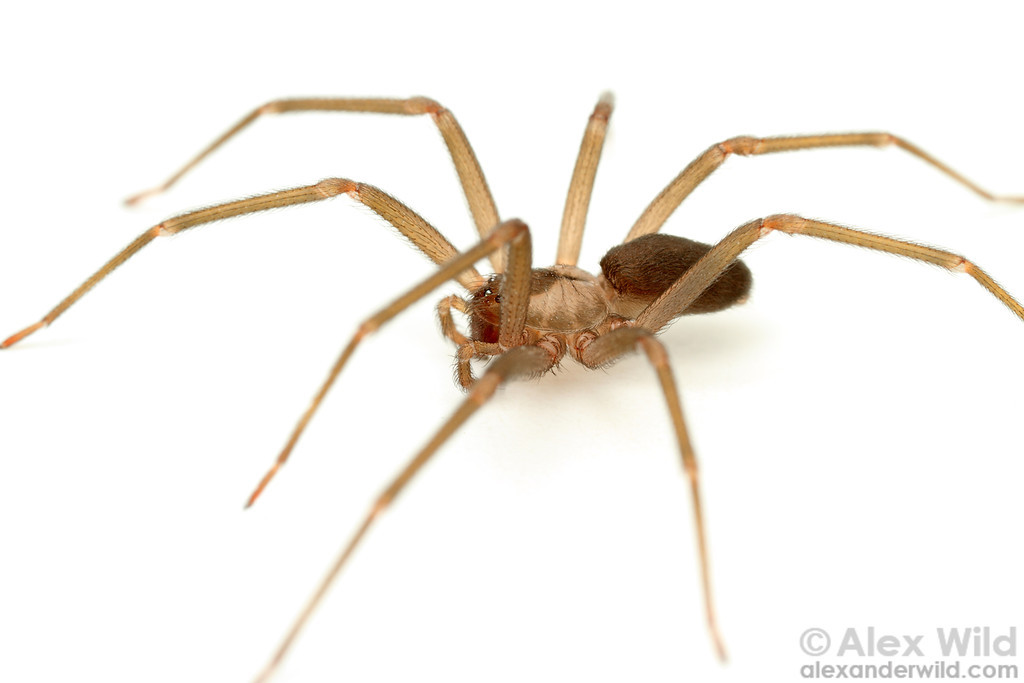
A female brown recluse, Loxosceles reclusa. Photo: Alex Wild, used with permission.
The brown recluse spider (Loxosceles reclusa) is arguably the most feared and most misunderstood spider species in North America. So, here we will find out how to tell if a spider is not a brown recluse. But before we do, it’s important to note that even if you do find a brown recluse, it’s not that big a deal.
Arachnologist Rick Vetter is an expert on the brown recluse spider who has done a ton of research on where they are (and aren’t) and how dangerous they really are (hint: not as dangerous as you think), as well as spending a lot of time dispelling myths and misconceptions held by both the public and the medical community. His website is full of excellent resources, and is the source of most of the information here. I encourage you to peruse his website and the articles linked in this post yourself, but I will highlight a few of the more compelling reasons that the brown recluse hysteria is unwarranted.
A family lived in a house full of brown recluses (more than 2000 of them!) for half a year and not a single bite occurred. Even in places where brown recluses are common, bites are very rare. Of those rare bites the vast majority of bites can be effectively treated with RICE (rest, ice, compression, and elevation) without any dire consequences. The small percentage of bites that are very serious are the ones that get all the attention in both the medical literature and the media, which has led to the misconception that recluse bites are always severe, require hospitalization, result in extensive scarring, and so on. Furthermore, misdiagnoses of all manner of other (more serious) conditions as brown recluse bites are rampant throughout North America (even in areas where the spiders do not occur), adding fuel to the already raging fire.
Now that all that’s out of the way, here is a series of questions to determine if a spider is NOT a brown recluse**. (Some of these may seem silly, but many of the spiders below that are not brown recluses are regularly misidentified as brown recluses by non-experts. Many people aren’t aware just how many different kinds of spiders there are, and for some, seeing brown, any marking vaguely reminiscent of a violin, and 8 legs is enough to conclude that a creature as a brown recluse.)
For those who want to skip the fine print, if the answer to question 1a or 1b is “yes”, it’s probably not a brown recluse. If the answer to any one of the remaining questions is “yes”, it’s definitely not a brown recluse.
1a. Are you in Canada (or Alaska)?
The range of the brown recluse spider does not extend into Canada. If you are in Canada, you are extremely unlikely to encounter a brown recluse spider. (Also see notes under 1b.)
1b. Are you in a state outside of the range of the brown recluse?
Above is a map of the known ranges of all of the species in the genus Loxosceles in North America. If you are anywhere outside the red-outlined region, you are very unlikely to encounter a brown recluse.
[update 2021] Below is an updated range map based on the latest data, made by Matt Bertone. For more information about recluse spiders, check out our Recluse or Not? page.
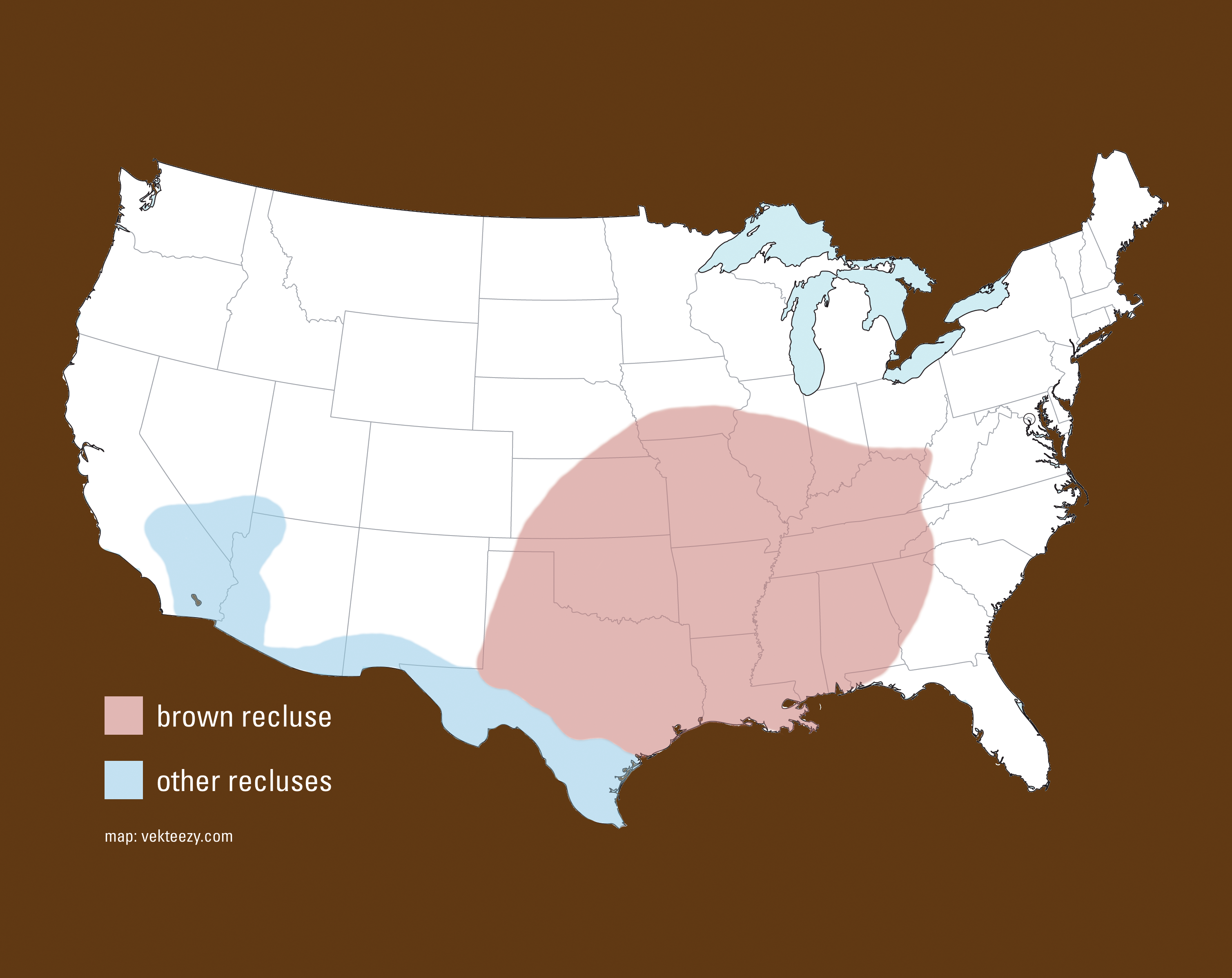 Brown recluses are occasionally found outside this range – sometimes they hitch a ride with people moving around the country (in boxes that have been stored in basements, for example). But even in these cases they will typically remain in the building into which they are introduced because they are very poor dispersers. Just because one or a few brown recluse spiders have been found in a new area does not mean that their range has expanded or that they are abundant there. (Note: A brown recluse spider bite diagnosis in an area outside their range does NOT mean that brown recluse spiders have been found there. Many doctors erroneously diagnose spider bites in the absence of any evidence, namely a spider that has been identified as the culprit.)
Brown recluses are occasionally found outside this range – sometimes they hitch a ride with people moving around the country (in boxes that have been stored in basements, for example). But even in these cases they will typically remain in the building into which they are introduced because they are very poor dispersers. Just because one or a few brown recluse spiders have been found in a new area does not mean that their range has expanded or that they are abundant there. (Note: A brown recluse spider bite diagnosis in an area outside their range does NOT mean that brown recluse spiders have been found there. Many doctors erroneously diagnose spider bites in the absence of any evidence, namely a spider that has been identified as the culprit.)
2. Is it on a web out in the open?

Some brown web-building spiders that are not brown recluses. Clockwise from top left: common garden spider (Araneus diadematus) on orb-web, dome-web spider male (Neriene radiata) false widow spider (Steatoda grossa) on cobweb giant house spider (Eratigena atrica) on funnel-shaped sheet web. Photos: Sean McCann.
If you find a brown spider on a web out in the open, it is not a brown recluse. Unlike the various brown web-building spiders shown above, each with their different types of web, brown recluse spiders do not use silk for prey capture. They do build small irregular silk retreats in which they hide during the day. These retreats are made low to the ground and out of sight in cracks and crevices or under objects like rocks.
Update (8/06/2015): I should mention that house spiders in the family Agelenidae are probably the most likely spiders to be mistaken for brown recluses in Canada. While females will usually be found on their webs, males are often found out and about when searching for females. They all look pretty similar to the one pictured below, but see this post for more information house spiders and hobo spiders.
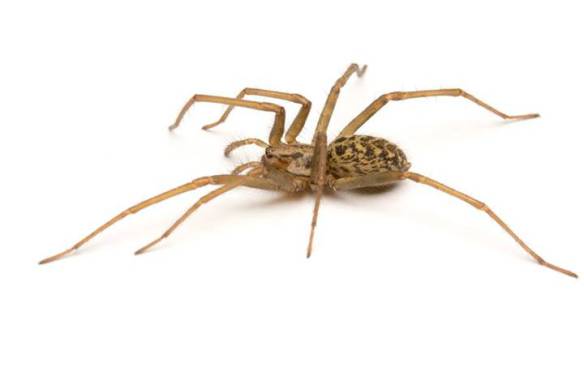
Female giant house spider (Eratigena atrica – formerly Tegenaria duellica). These spiders are often mistaken for recluses, but note the pattern on the abdomen. Photo: Sean McCann.
3. Does it have stripy or spiky legs, or more than one colour on its abdomen?
If you find a spider that has stripes or large spines on its legs, it is not a brown recluse. If it has a patterned abdomen, it is not a brown recluse.
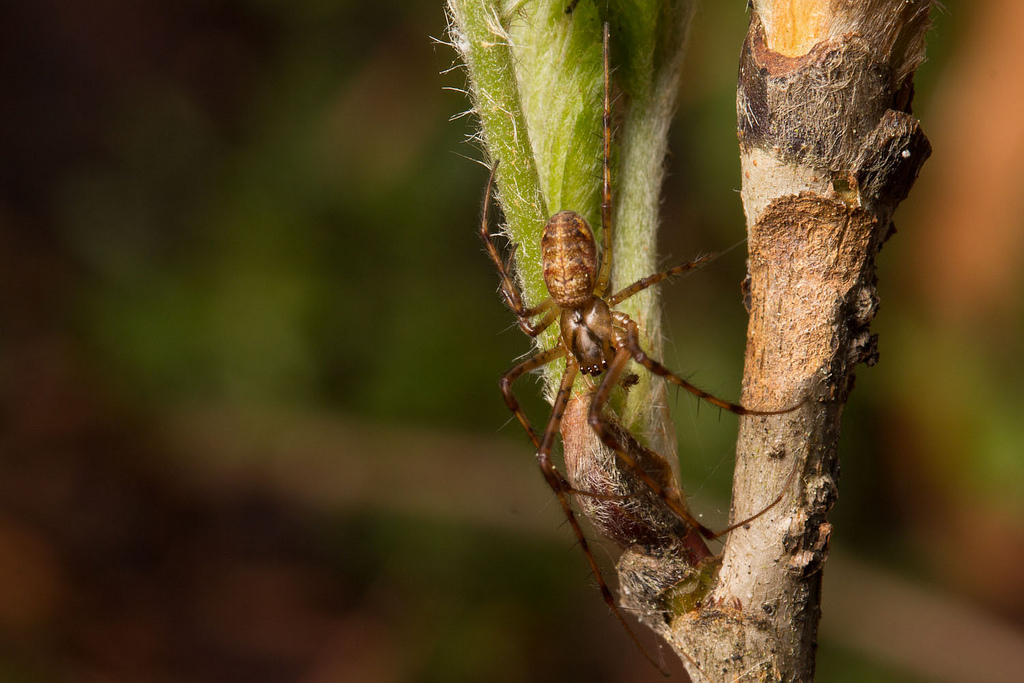
Stripy legs with large spines + patterned abdomen = not a brown recluse. Photo: Sean McCann.
Brown recluses have plain brown abdomens and plain brown legs with fine hair but no large spines.
4. Does it have extremely long and skinny legs?
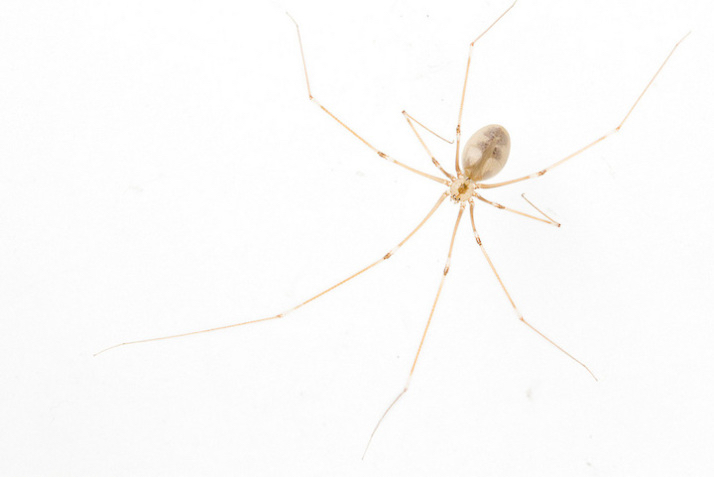
Cellar spider, Pholcus phalangiodes (family Pholcidae). The dark spot on the cephalothorax looks a bit like a violin, but do not be fooled. This is not a brown recluse. Photo: Sean McCann
If it has extremely long skinny legs like the spider in the image above, it is a cellar spider (or daddy-longlegs), not a brown recluse. Despite looking very dissimilar to brown recluses, these spiders are often mistaken for brown recluses because of the “violin” mark on the back. Having a violin-shaped marking is not, by itself, a good way to determine if a spider is a brown recluse.
4. Is it really big?
Brown recluses are not huge spiders. If its body length (not including legs) is more than 0.5 inches or about 1.25 cm, it’s definitely not a brown recluse.
5. Does it have 8 eyes?
This is the dead giveaway, provided you are close enough to the spider to count its eyes. If it has 8 eyes (like most spiders), it is not a brown recluse. Below are some 8-eyed spiders that are sometimes mistaken for brown recluses.
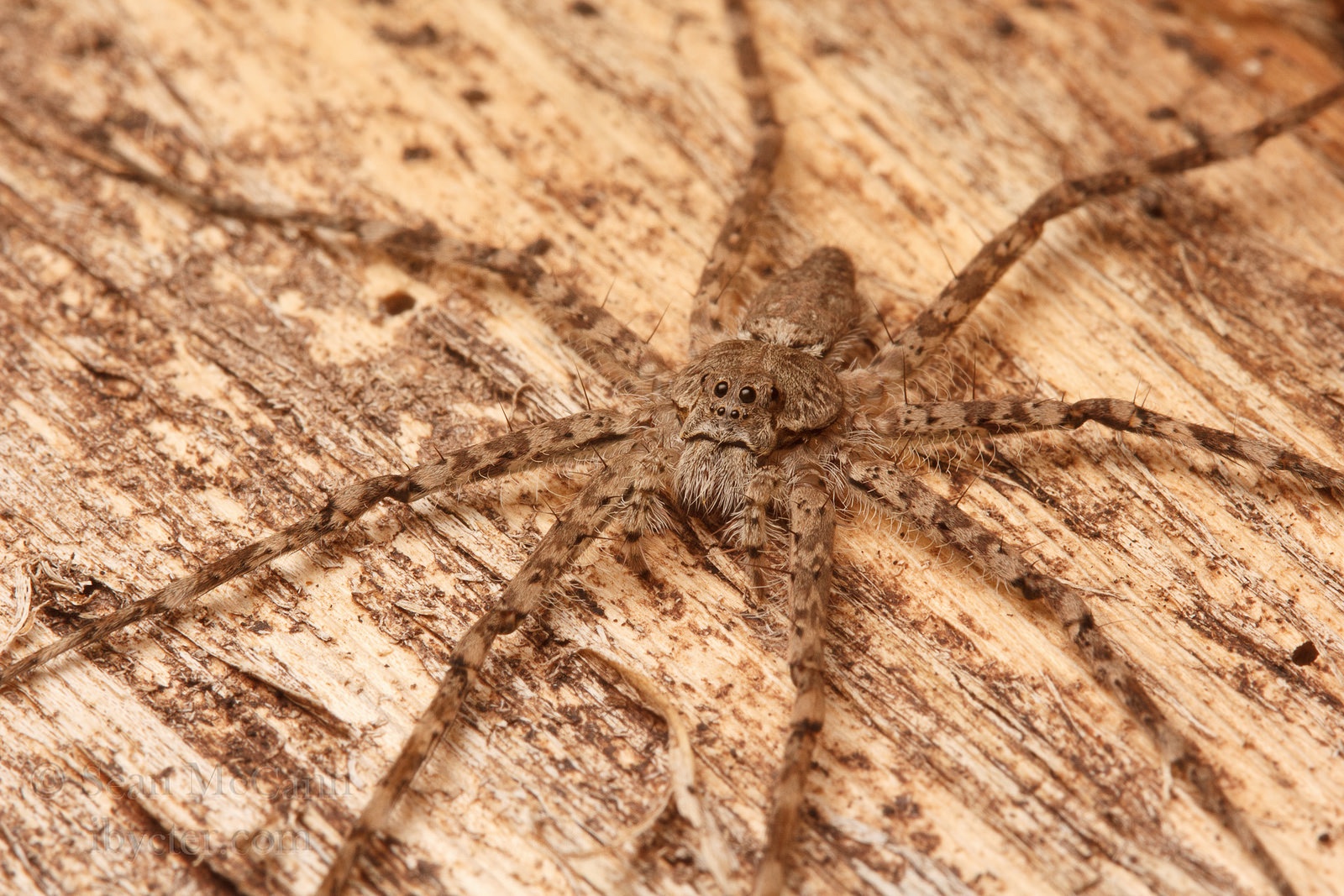
Fishing spider (family Pisauridae) actually a close relative of fishing spiders in the family Trechaleidae, with 8 eyes. Also see: stripy, spiky legs. Photo: Sean McCann.
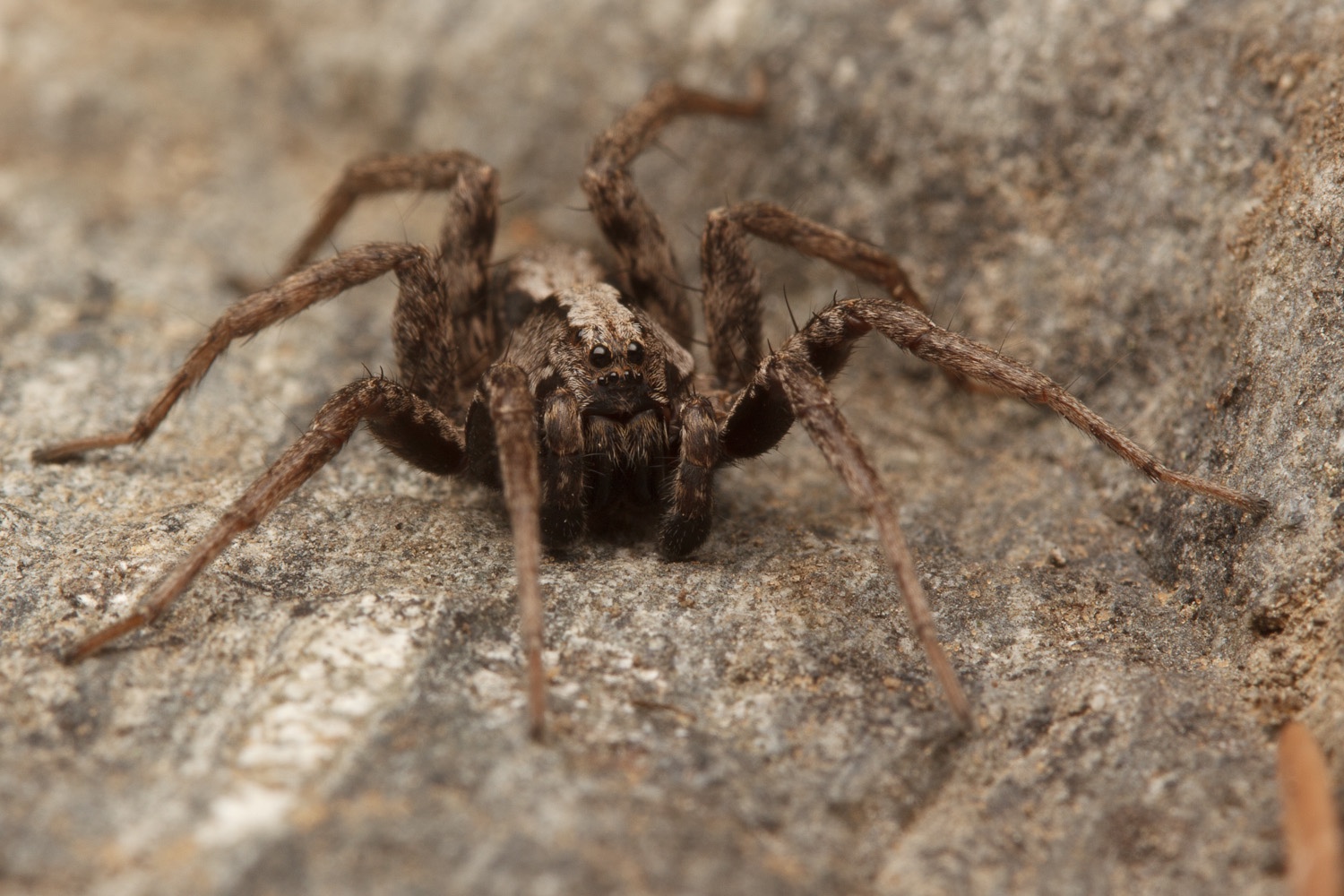
A wolf spider (family Lycosidae). Wolf spiders have 8 eyes and spines on the legs. Photo: Sean McCann.
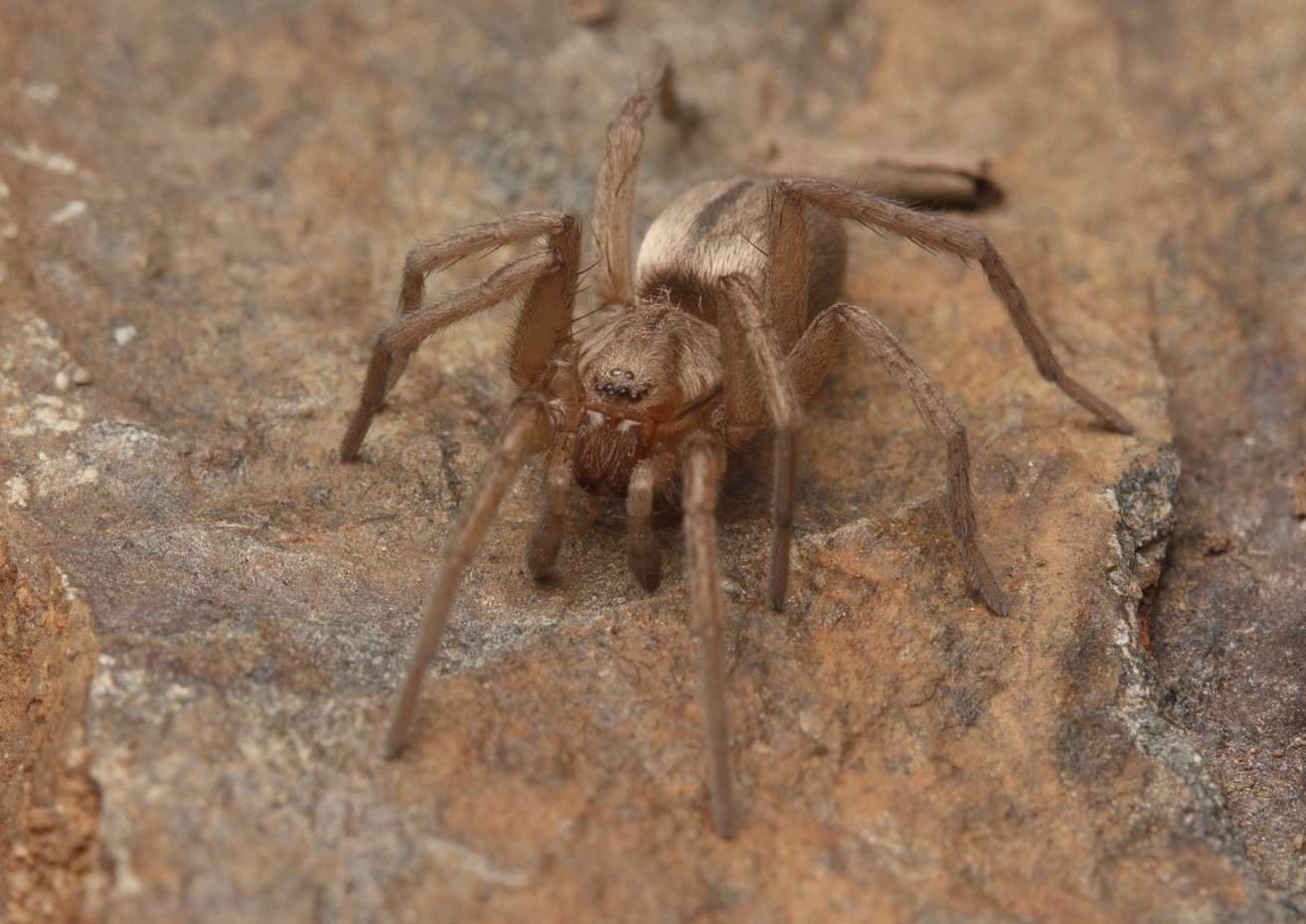
A sac spider (family Clubionidae) A ground spider (family Gnaphosidae, genus Drassodes). It looks a bit like a brown recluse, but again, has 8 eyes, some larger spines on the legs, and a dark stripe on the abdomen. Photo: Sean McCann.
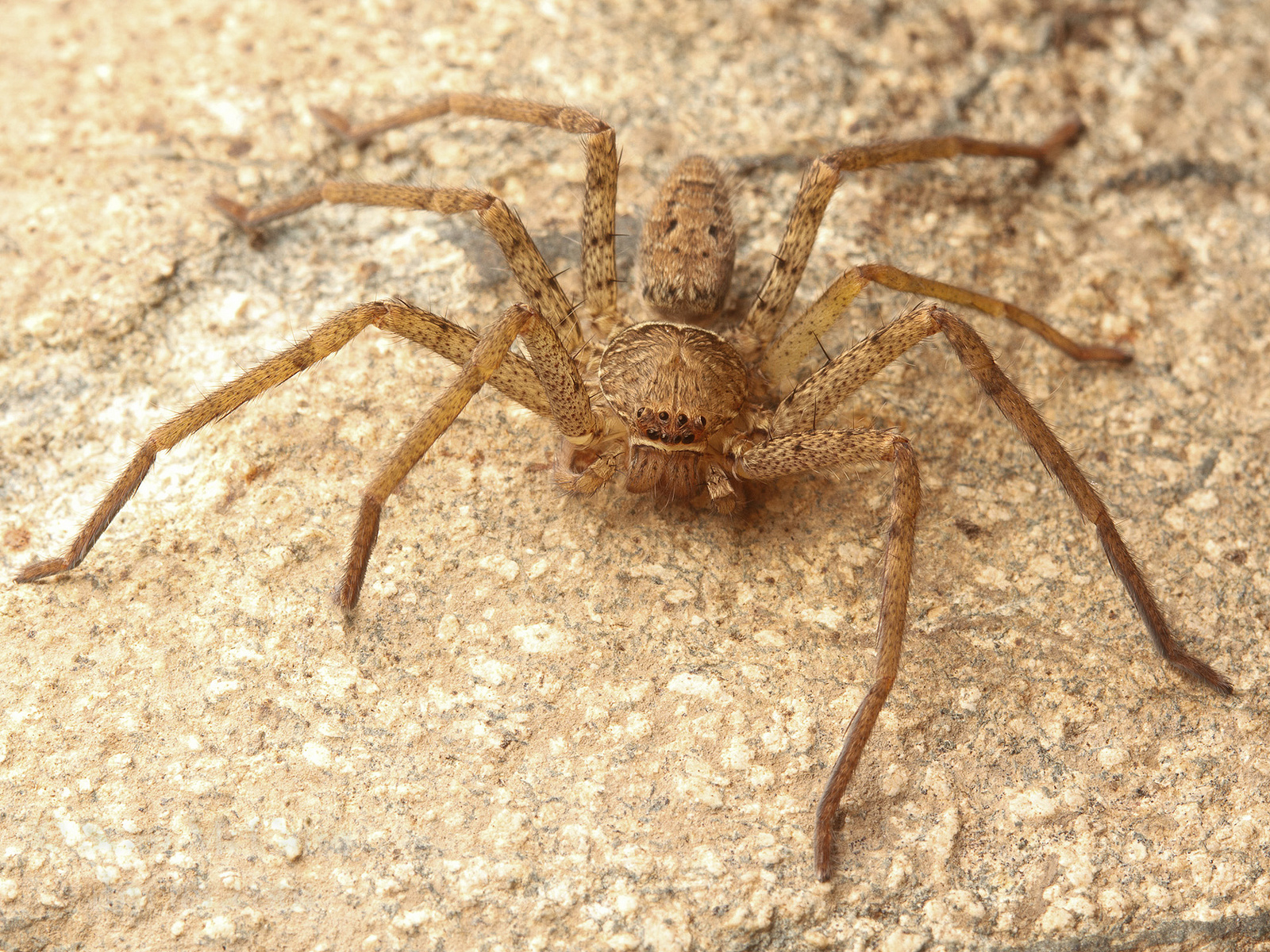
Huntsman spider (family Sparassidae). These spiders are fairly frequently mistaken for brown recluses. Note the 8 eyes in 2 rows, and spines and darker dots on the legs and abdomen. Photo: Sean McCann.
Update (12/06/2015): Another 8-eyed spider that can easily be mistaken for a brown recluse (and is common in the southern states) is the male southern house spider. It has a similar violin-like marking on the back, but several other features that distinguish it from brown recluses. The 8 eyes are all tightly clumped together, it has conspicuous spines on the legs, and its pedipalps (the two small leg-like appendages at the very front end of the spider) are extremely long and stick straight out in front of its face (compare to a male brown recluse spider here).
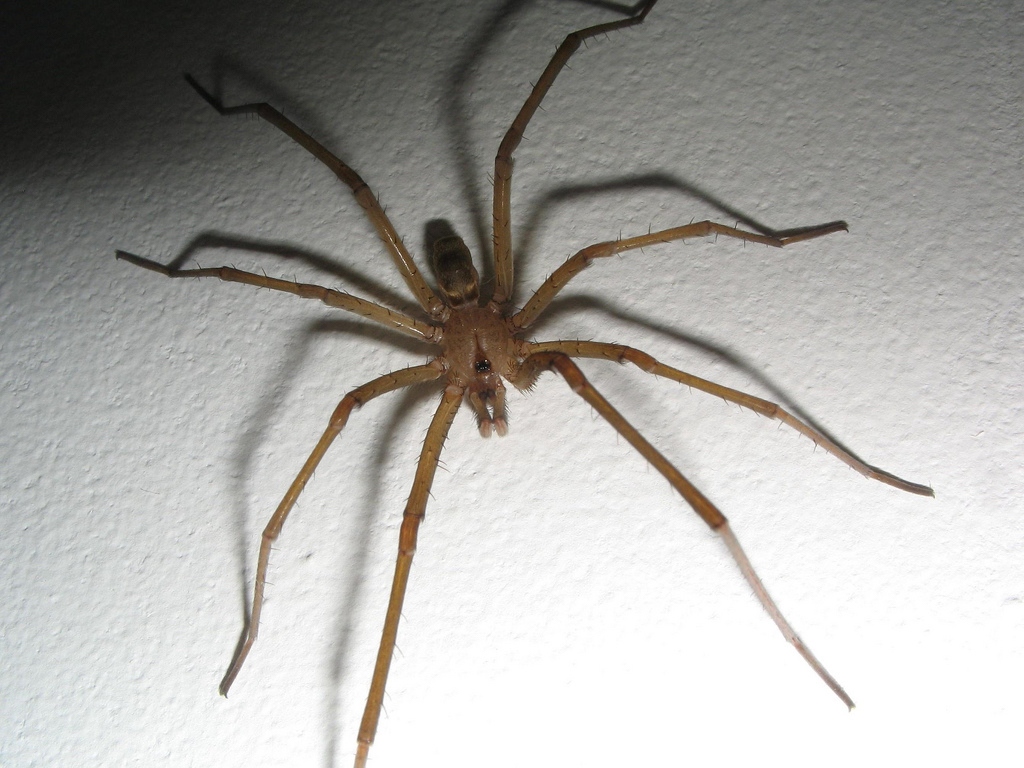
Male southern house spider (Kukulcania hibernalis). Photo: Sam Heck, licensed under CC BY-NC 2.0.
Some other spiders that are not brown recluses, like the woodlouse hunter Dysdera crocata, also only have only 6 eyes, but they are arranged differently (not to mention D. crocata is red or pinkish or orangish in colour, not brown).
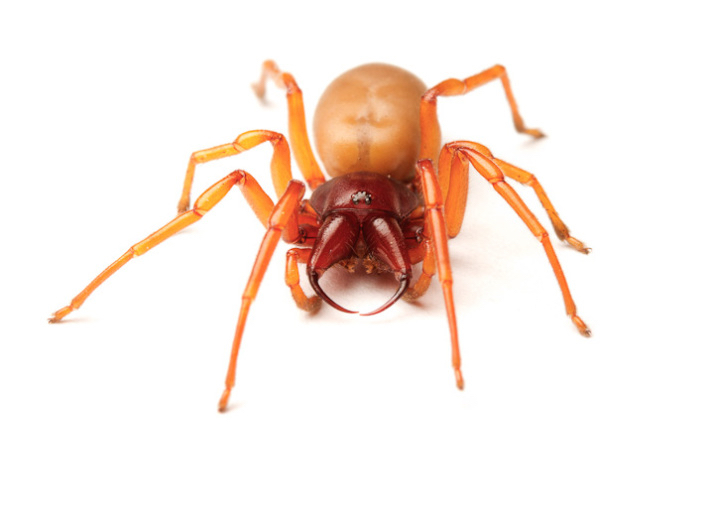
Female woodlouse hunter, Dysdera crocata. Her 6 eyes are all in a tight bunch in the centre of the cephalothorax, and her massive fangs are much larger than those of a brown recluse. Also, these spiders are not brown. Photo: Sean McCann.
Brown recluses only have 6 eyes, arranged in 3 pairs.
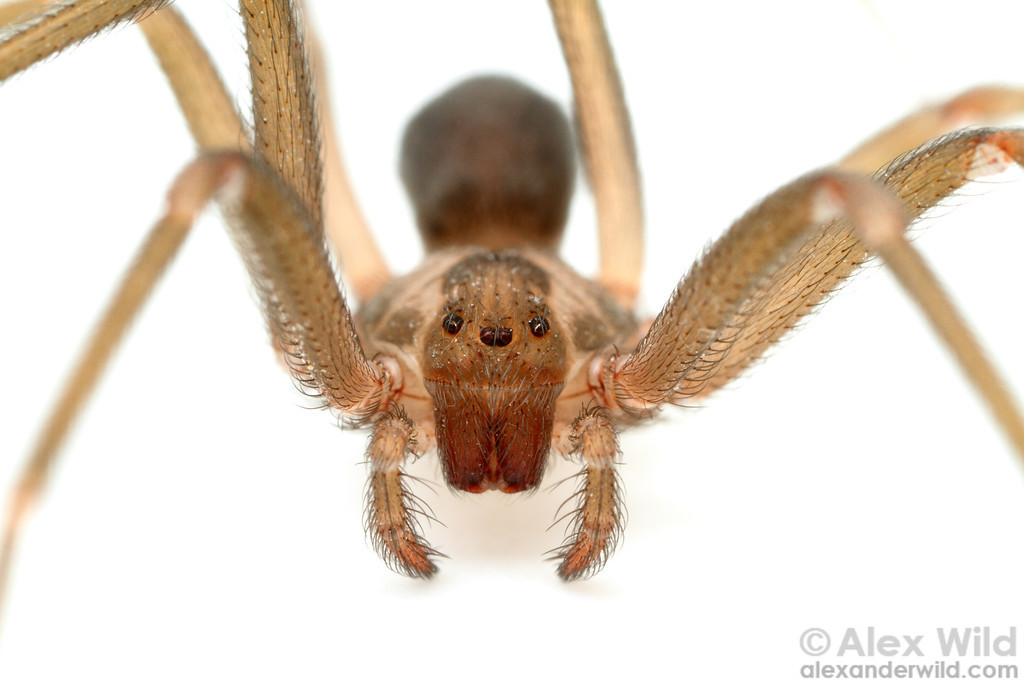
This is a brown recluse. It has only six eyes. Also note the fine hairs on the legs, but no spines, and the plain brown abdomen. Photo: Alex Wild, used with permission.
If you answered no to all those questions (or all but questions 1a and 1b and you’re really lucky!) AND the spider looks just like the one in the image above, then you’ve found a brown recluse. If not, then it’s another kind of spider that is totally harmless. (The only other medically significant spiders in North America are black widows). Either way, please remain calm. Spiders are not out to get you, and will leave you alone if you leave them alone. Here are some tips for avoiding brown recluse bites if you do live within their range. Still not sure about any of this? Please feel free to tweet at me (I’m @Cataranea on twitter) or comment here if you have any questions and I’ll be happy to try to answer them.
*I’ve also started answering this question on twitter with the hashtag #notabrownrecluse. This campaign, with the goal of educating people about the brown recluse spider, is a blatant ripoff of inspired by wildlife biologist David Steen (he’s @AlongsideWild on twitter), who tweets snake identifications using the hashtags #NotACottonmouth and #NotACopperhead. For more about his awesome twitter outreach, check out this excellent article: ‘This snake scientist is the best biologist on twitter‘.
**This guide is based on the following resources:
Vetter, Rick. (1999). Identifying and Misidentifying the Brown Recluse Spider. Dermatology Online Journal, 5(2). link
Vetter, Rick. (2009). How to Identify and Misidentify a Brown Recluse Spider. Web Resource. link
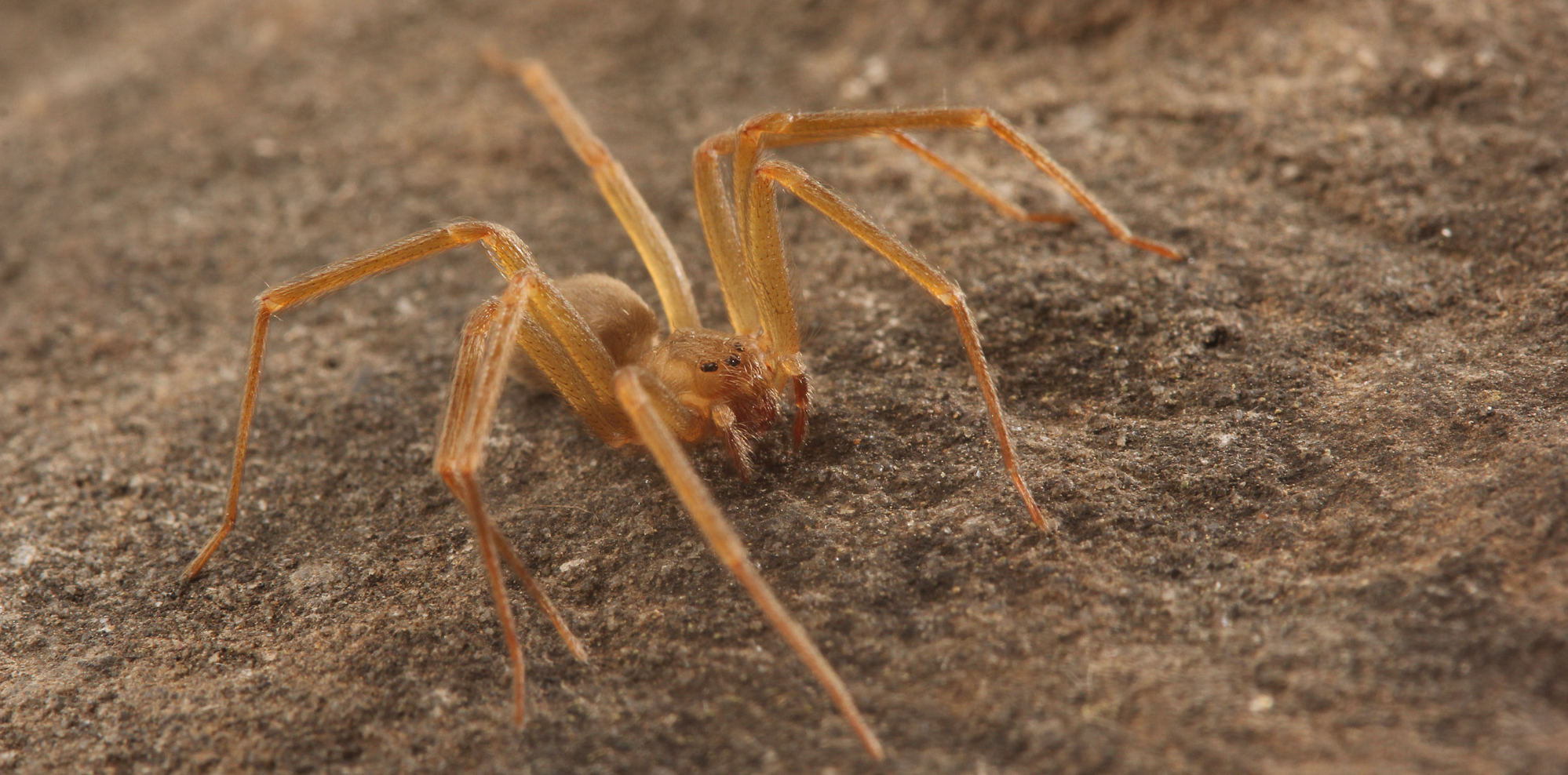
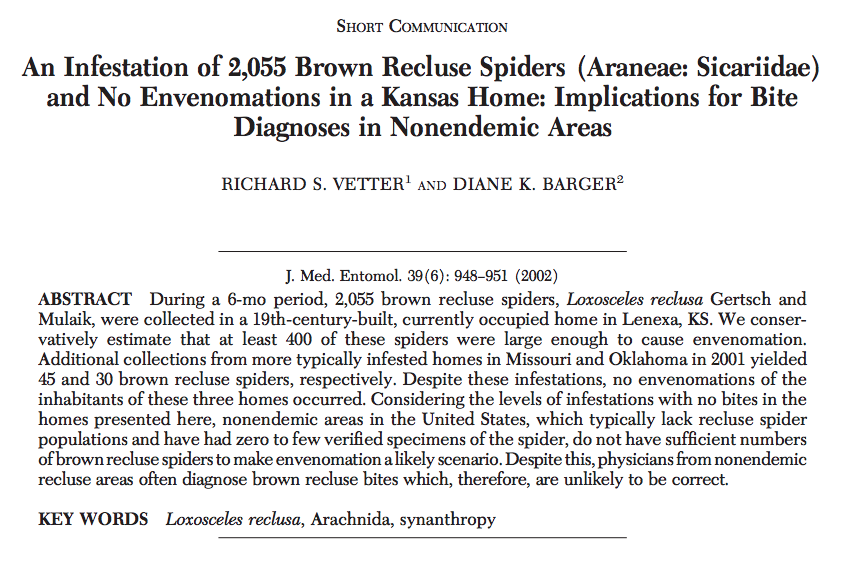
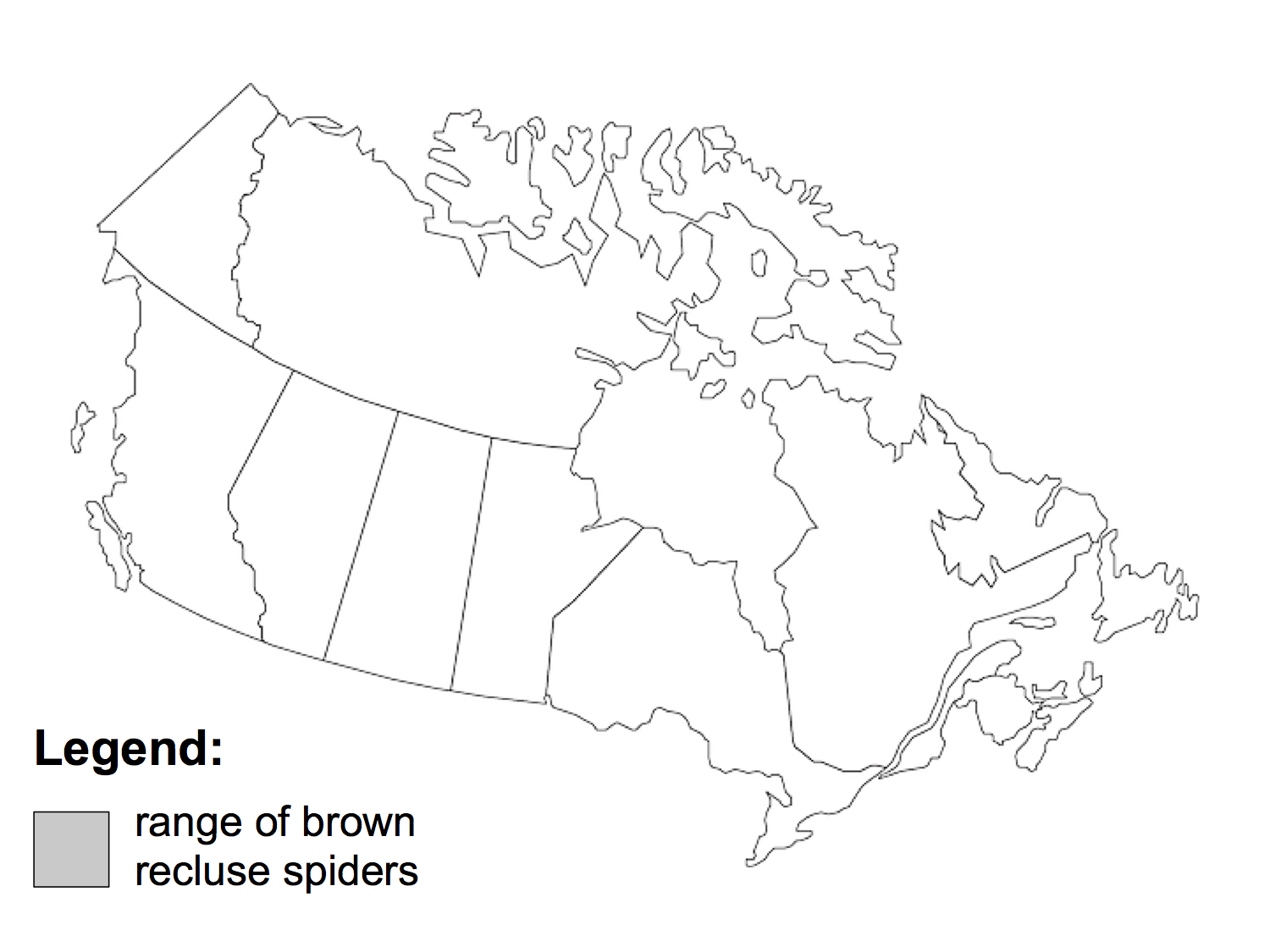
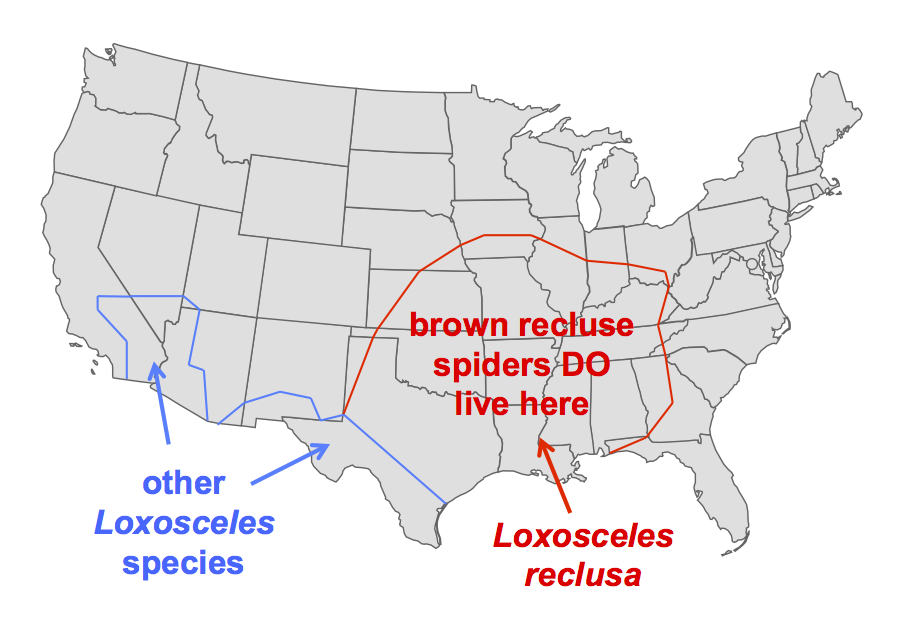
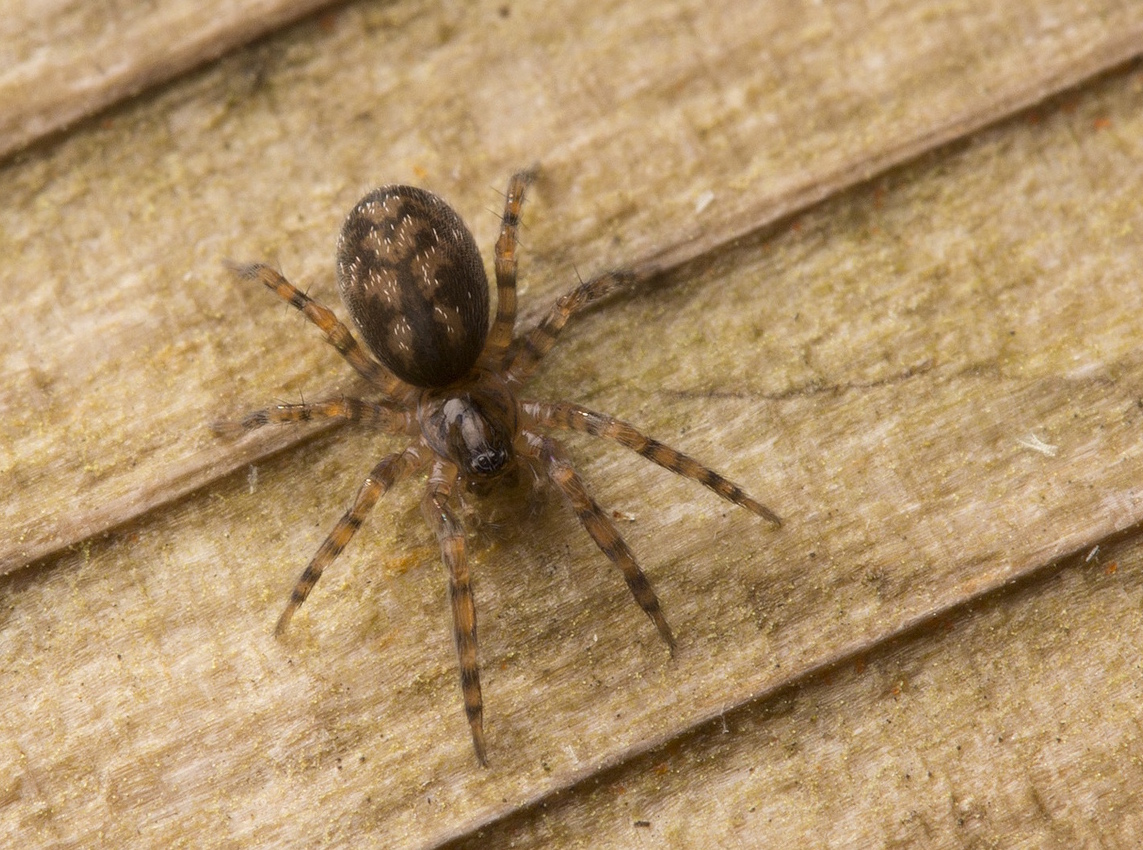
Wonderful blog. Simply perfect. I’m sharing all over the place.
Lynne
Thanks so much Lynne!
I live in ky and I see these brown spiders with long legs and when u kill it it shrinks and has black on it and looks like brown recluse. It is in my house crawling everywhere my son likes sleeping on the floor I’m scared dor him please help me
I wish you would update your information. I live in Colorado and I was bitten by a Brown Recluse. Rick Vetter is not correct and his map is outdated. Many sources use the map he published,and the ER Drs.use it also. I know of several cases in the front range. I felt and caught the spider that bit me. I then threw it in the fire I was tending. I had pretty bad symptoms and a quarter sized ulcerative wound. I had to get a second opinion because of Rick Vetter’s map.
Hi Jackie,
Thanks very much for commenting. I will be updating the post on Oct. 1. There will be more information then, but as part of a new outreach and citizen science campaign I will be soliciting records of brown recluse spiders from outside their native range to help with a scientific study being done by some colleagues to determine where in North America they are. There are some verified records of individuals and populations outside the range indicated on the map but we don’t yet have a good understanding of where they are and whether and how their range is expanding. Rick Vetter’s map is based on the best available research, but more research needs to be done, and will be soon. I am sorry to hear about your experience.
We do have brown recluse spiders in Canada, on Vancouver Island and Fort St John so please update your information
To the best of my knowledge, no (verified) brown recluse spiders have ever been reported from Vancouver Island, or anywhere else in BC, although I hear from a lot of folks who think they are present here. I don’t know where the idea that they are here comes from, other than folks getting diagnosed with “recluse bites” by BC doctors who don’t know that the spiders are not present here. It’s possible that one or two brown recluse spiders could have been transported into BC at one time or another, but no specimens or photos have ever been provided to experts for verification, and the likelihood of anyone getting bitten by such stowaways is extraordinarily small. If you (or anyone else reading) have seen spiders that you believe to be brown recluses here in BC, I would very much like to see photographs for verification, and to improve the information scientists have about their current range.
I live in Kamloops, British Columbia and there are 100% Brown Recluse, Hobo Spiders and Black Widow spiders here. I encounter them often. You have to update your information, because it is false. There are over 900 species of spider here in British Columbia.
You are correct that there are over 900 spider species in BC. Black widows and hobo spiders are among them, but brown recluse spiders are not.
I’m sorry but there really are no Brown Recluse that far north other than the occasional hitchhiker. There are several spider that look similar and are mistaken for the Brown Recluse. Please take a look at THIS article as a companion to the above article. https://spiders.ucr.edu/necrotic.html
I would expect the range of the Brown Recluse to increase over time with global heating.
There is a paper that has predicted areas of North America that would become suitable habitat for brown recluse spiders here: https://journals.plos.org/plosone/article?id=10.1371/journal.pone.0017731. However, just because habitat is suitable, doesn’t mean the brown recluse spider will expand its range and get there. Recluse spiders are extremely poor dispersers. When they are brought to a new place by humans, they typically stay in the same building, and years later are not found even in neighbouring buildings. This means the likelihood of their range dramatically shifting is very low, although with human movements I expect that isolated new populations in buildings may become more common.
I live in upstate South Carolina and I have killed several brown recluse spiders in my home. I was also bitten by one I took the spider to the ER . I was very lucky that I didn’t have more problems. I do think that the map should be updated.
Thanks for commenting! I’m very sorry to hear that you were bitten by a recluse. Brown recluses do occur outside the boundaries shown on the map, and we are trying to learn more about exactly where they are with a new project called recluse or not (more info: http://spiderbytes.org/recluse-or-not/). We would really appreciate it if you could contribute to the project.
I’m 10/10 very impressed with your ability to reply to people who adamantly arguing with you about how your information is wrong. Very professional and I am willing to bet you probably have worked in costumer service. I actually have a super mild (it’s almost gone – almost!) arachnophobia and I was in a fire station in Texas and I saw a massive (possibility 2 inches but probably smaller and my fear’s just making it seem bigger) brown spider and I had just learned about brown recluse spiders in the EMT course I’m taking and I was like “Oh $#1+! I’m think that’s what I just learned about???” So I started googling some things to try and figure out if it was a recluse or not (I did kill it which I’m sort of proud about because in the past I would run and hide). Anyway, all that to say I’m not so sure if it was a brown recluse or not but it did meet all of your criteria.
Thanks so much! I sure have worked in customer service! If the spider was quite large, it was almost certainly not a recluse. I would bet southern house spider.
I Live in NY and there have been a few bites by brown recluses that I’ve seen as well as many reports of them..
In what context have you seen bites?
Always so interesting reading your posts, the more spidery the better. I’ll look forward to more of them.
There’s another brown spider that is dangerous and becoming quite common in the Florida area.
The Brown Widow. It has the same hourglass as a black widow on the bottom of their abdomen. If you get a close look they’re brown with darker brown or green markings on their abdomen.They have long legs with darker areas on the joints. They’re actually kind if beautiful markings. They make a messy looking web in a corner somewhere.
They’re not aggressive that I’ve noticed. But I wouldn’t want to get bitten so I stay back.
I found two in my garage on either side of the door. I found one under my daughters bike set. Another in a drain pipe, on a fire hydrant, in the eves of a covered patio, and on the back of a patio chair.
I live in St. Augustine, Fl.
Thanks for commenting! Yes, when I said “black widows” are the only other medically significant spiders in North America I should have said “widow spiders” to include the invasive brown widow (there are also red widows in Florida!). They are indeed beautiful spiders, and not at all aggressive, just like their relatives the black widows. If you don’t bug them, they will definitely not cause you any problems! They are shy and very hesitant to bite. Do be careful reaching into dark corners or woodpiles or inside/under anything that’s been left outdoors in case they have built a retreat there, though. Accidentally grabbing them, stepping on them or crushing them (if they are hiding in a boot or work glove for example) *is* a good way to potentially get bitten.
Can you help me determine if the spider I saw in my car this morning is a recluse? I have a picture. I am in Jacksonville, FL, just a few miles North of St. Augustine.
Sure! You can email the picture to me – catherine.elizabeth.scott[at]gmail.com
Can you tell me spider this is? In eastern Washington.
Thanks for sharing
thank you! I have been trying to explain that the odds of finding a Brown Recluse in North Carolina are extremely slim. Still I hear doctors tell patients bite are likely from a recluse all the time!
You’re welcome! I hope this post proves useful! Doctors also (mis)diagnose brown recluse bites in Canada all the time as well, making people think they are here, which they are not!
Pingback: Spiderday (the seventh) | Arthropod Ecology
When a misdiagnosis occurs, what is being misdiagnosed?
Especially if widow spiders are the only other medically significant spider.
So what is biting people to give them a reaction that they need to have treated?
And thank you for breaking down the identification process so neatly.
Great question. There are many things that are misdiagnosed as spider bites. It could be a bad reaction to a bite from another arthropod (ones that are far more likely to bite than spiders, because they actually feed on blood, which spiders do not) such as a tick, flea, or mite. In many cases, necrotic lesions are diagnosed as brown recluse bites even when there is no reason to think that a bite ever happened – it could be a tiny scratch that got infected, for example. Here is a list from Rick Vetter of some of the many things that have been misdiagnosed as brown recluse bites: http://spiders.ucr.edu/necrotic.html (scroll down to the table at the bottom of the page). It is important to note that some of these – Lyme disease for example – can become very serious if not treated correctly. If a person has Lyme and is treated for a recluse bite (treatment is RICE), they will not get appropriate care (Lyme can be effectively treated with antibiotics, but gets much worse if these are not administered right away) and the outcome will be far worse. This is why misdiagnosis of spider bites is so harmful. Another post on the topic here: http://spiderbytes.org/2014/09/25/the-truth-about-spider-bites-aggressive-spiders-and-the-threat-to-public-health/
thanks. good to know these things.
Pingback: All about spiders | Welcome Wildlife.com
Pingback: Arachtober | Arthropod Ecology
Hello,
I am so glad I stumbled upon your blog as I was hoping to tell myself I did not see a brown recluse. I have night terrors and it’s always the same where I get attacked by spiders. So needless to say I’m not a big fan of being too close. Any how I live in southern Indiana and I was in our laundry room I moved some closed and what looked like to me a brown recluse and it moved really fast and I saw a tiny bug running from it. It moved fast and seemed defensive not sure if that’s a characteristic of them or not? I live by a lot of farm land also. So my biggest fear is that I have a two year old and I’m afraid what if he sees one and attempts to grab it or get close to it? Are they generally the type to stay inside the home or lay eggs around? Sorry I know these may seem silly I just have no idea.
Thanks,
Mercedes
Clothes*
Hi Mercedes, thanks for commenting! Your questions are not silly at all. You could very well have brown recluse spiders where you are in Indiana. To find out for sure, you could put sticky traps out along your baseboards and then if you capture one it would be easier to identify. It’s really hard to say just from the behaviour you described what kind of spider it might be. Recluses like to live in dark spaces and hide out in cracks and crevices or behind things – they generally aren’t found out in the open, so I doubt there is much risk of your child seeing one and grabbing it. Also they are very fast and would likely run rather than turn and try to bite if someone was attempting to catch them. That said, Rick Vetter has some good advice here: http://spiders.ucr.edu/avoidbites.html on avoiding bites if you do have recluses in your house. The danger is having lots of cluttered objects or clothes that recluses might be hiding under or inside, and then accidentally grabbing the spider when reaching behind or in those objects, or putting on clothes that the spider is inside. Unless they are being grabbed or crushed, most spiders are very hesitant to bite! I hope this helps, and please don’t hesitate to ask if you have further questions! You can also email me – my contact info is on the about me page.
Thanks! I’ll be sharing…I am really getting bothered by how this spider has been maligned. Every brown spider in the U.S is in danger of being squashed…even though they eat flies and everybody knows there is nothing grosser than a maggot!
Great article, one thing, your Clubiona looks an awful lot like a Drassodes. .. notice the AME’S
Thanks so much for the tip! You are right, it is Drassodes – we did not correctly ID it until after I made this post. I have now corrected the caption!
Thanks for the change, one more, I promise I’m done 😉 Tegenaria atrica has been changed to Eratigena atrica.
Oh good catch – I knew that! You’ll see earlier in the post I used Eratigena atrica, but then relapsed for the second caption! Still getting used to those name changes.
And by “earlier” I mean later. Thanks again!
Very good information. Thank you. I live in Missouri so 1b was yes and I live in the country. I learned most here are orb or the many looks of wolf spiders. Although after being bitten by ‘some kind of spider’ to just be more careful. I rarely rake leaves in fall anymore. I didn’t see what bit me but sure felt it afterwards. Belly bite left a scar about nickel size. Swelled and became pussy within the hour. Used Epsom salt compresses and antibiotics and eventually went away. I’m saving this to post to friends.
Pingback: Summer 2015 | MENTAL PLOPS
Im pretty sure I just ran across a brown recluse 30 minutes ago when I began stepping into the pool to clean it (above ground pool). So I researched photos and sure enough almost exact to several pictures shown of brown recluse spider. I had my son come with me to take a photo and he first said “mom stop freaking out its just a wolf spider!” He left me outside alone in pool, trying to get it out so I could clean it, then a few minutes later he was right beside the latter checking on me. Saying he looked it up and realized it was NOT a wolf spider. Now I am too scared to get in to clean it, unsure how many more might be lurking around. Any advice… yoUnger sons party is this Saturday and was hoping to have pool clean and atleast 1-2 ft of water to splash around. Thanks for all your info above, and any other you may have as well. Very helpful. Sabrina
Hi Sabrina,
Recluse spiders are unlikely to bite unless they are trapped against your body, so I would recommend cleaning areas where you think they might be wearing long sleeves and pants and gardening gloves. Rick Vetter has some information here on how to avoid bites: http://spiders.ucr.edu/avoidbites.html. Hope this is helpful – please feel free to email me if you have further questions!
Are brown recluse common to be seen kust crawling around the house or do they try to stay hidden
They generally try to stay hidden (they are not called “recluse” spiders for nothing!) but sometimes you may see them wandering.
I am at my grandmother’s house letting kids stay cool in this summer heat (grandmother has been in nursing home for several months house has been empty) I was going through a closet in the dining room and bumped into some table cloths hanging on closet door when I seen a spider shoot up the side of cloth. I caught it in a jar and have googled it and am almost 100% it is a Brown recluse now just second guessing if here in the a/c is safer then home in a 90° house??? Help please is there anything I can do to help make sure there are no more???
Hi Sarah, if there are brown recluse spiders in the house here is some good information on how to avoid bites: http://spiders.ucr.edu/recluseid.html
Putting out sticky traps is one way to see if there are more around. If you have more questions, please feel free to email me at catherine.scott [at] mail.utoronto.ca
Can u tell me if i have captured a br please
Sure, send me an email and I can try to help!
When I was younger I had gotten bitten by something (southern Kansas). On day 2 the bite was a bullseye of red, purple, black and white. I was taken to the ER where they gave me a shot. They had said it was just a brown spider but not a brown recluse bite. Is that even possible?! Also, I think I might have seen one on my bed last night. Although, I squished it in my panic and squished it a little too hard to where it now doesnt have an abdomen. But there is a fiddle-like shape on its back and its legs are all one color. With legs stretched out it was about the size of a quarter. It ran from me instead of to me (hallelujah) but still scared the crud out of me! I usually don’t mind spiders and just leave them be, but if they are within 1 foot of me or on me they are getting crushed! Because I’m a pansy!
It’s impossible to know what caused the bite you describe unless you saw what bit you. As for the spider on your bed, it does sound like it could be a brown recluse. Here is an excellent resource on how to avoid bites if you have them in your home: http://spiders.ucr.edu/avoidbites.html
Pingback: Announcing Spider Week | spiderbytes
I found a spider that looks just like a brown recluse this morning in my kitchen. I have a ton of spiders almost a infestation but was never scared till today.I’m 99.9% sure it’s a recluse but I live in Maryland so what do you think? Also could there be more? I have a picture but it’s from a distances lol.
Please feel free to email the picture to me and I will take a look!
Very nice article. I really enjoyed reading it. I live in west Texas. I have found about 6 brown recuses in the past 2 weeks. I will admit I killed one. Just because I was putting my leg though a pair of shorts and saw it out of the corner of my eye and flipped. But the others have been released outside. The arachnids we have are amazing. I love the sun spiders just amazing creatures, but my wife just absolutely hates them.
Southern house spider. Im not gonna get much love from an arachnophilanthropist such as yourself, but anything that looks that much like a brown recluse isnt going to live long. It wasnt until I saw ths blog that I know the species existed. I smashed one weeks ago thinking I had finally seen a brown recluse. I have huntsmen spiderscrawl under my door and unless its a female either carrying or covered I leave them to the mercy of the gauntlet of cobweb spiders I have inhabiting the underside of my cabinets. Sometimes I even toss them back out. But the risk, however small, of drastic permanent damage to any part of my body is not worth sparing a potential danger I can see plainly.
Thankyou for finally putting to rest the trouble of finding a good source for what IS a brown recluse. You’d be amazed how hard it can be just to get a good picture of something so widely known in this day and age of cameras everywhere.
Excellent information to have! I live in SC, and people are always thinking they have seen a brown recluse. I have now shared this to my fb page. Thanks!
I live in MS and we recently rented a very nice house but no one had lived there for several months. I was cleaning one day and found what I am almost sure was a brown recluse so I put out glue traps to see what else was crawling around. Within 4 days I had at least 15 of the same spider stuck on the traps. All sizes and a couple even looked to be pregnant. I contacted the landlord and she says they are not brown recluse. I have pictures. Could you please help me identify them?
Sure thing – please send me the photos via email!
I have a spider. Luxoceles Simillima. Are you at all familiar with this species?! After reading this post I am concerned that it is a cellar spider. I’d love help with the identification. I will later today try to zoom in on his carapace to see about the eyes. I’m 6 months into the hobby and would love to shoot you an email.
Please do send me an email with a photograph!
Pingback: Brown Recluse Spider | Home Wise! Family Smart!
You said the bite isn’t as bad as generally imagined, but you didn’t get very specific about that. Could you say more?
From Rick Vetter, the expert on brown recluse spiders: “Ninety percent of brown recluse bites are not medically significant, heal very nicely often without medical. intervention” More on his website here: http://spiders.ucr.edu/recluseid.html
Hi I live in northern KY in a condominium complex we have been noticing a lot lately that this place is covered inside and out in spiders more out than in but there are tons and tons of daddy long legs if you go outside at night and there atleast 20 of em but my husband and I have been seeing big brown spiders I do my even want a chance to get close to them to look at their body. Most of the time they run away even sometimes look as if they are hopping, they are fast and sometimes they come at us as if they are going to attack they are everywhere inside and out mostly only at night do we see them they are pretty big, about the size of a small hand. Can you help me out with what type they are? I have a 4 year old little girl that loves bugs and she try’s to catch them to play with them and while I don’t mind if she plays with bugs I won’t let her with these until we find out if they will hurt her
If you email me a photo (my email is catherine.scott [at] mail.utoronto.ca) I can try to identify the spiders you are seeing!
A BIG Brown Recluse will be about the size of a quater, or maybe a 50 cent piece. If you also see them out in the day, other than moving stuff(they love cardboard boxes), they are likely not a Brown Reecluse.
Thanks for all of this information I’m so scared of spiders. And I’ve seen more spiders in my home this year than I’ve seen in my life. And they look like the brown killer.
Hello!
This article calmed my fears some. We live in Kansas and I am terrified of spiders. We have lived in our brand new duplex for about 5 months and have seen a total of 10 or so spiders. All dead bc I am OCD about cleaning and spraying. I believe they were mostly wolf spiders. My neighbors had been having issues so we all had our houses dusted and sprayed professionally. I have seen one live spider that looked like a BR. If we did have them, would I be catching them on traps? The main area we ever saw them is completely clear of any creepy crawlers. I hear a lot about people catching them and wondered if maybe it wasn’t brown recluses or if we avoided an infestation?
Thanks for the advice!
Putting out sticky traps around baseboards is the best way to catch brown recluses. If you are not catching them, they are likely not there.
This is great news! I just checked and have had no activity on the traps.
Where do you get Sticky tape any other ways or sprays you can use
You should be able to find sticky insect traps at a hardware store or Walmart. Sprays will not be effective–please call a licensed pest control company if you have an infestation and they can help determine the best way to control the spiders. Also check out this helpful resource on how to avoid bites if you have recluses in your home: http://spiders.ucr.edu/avoidbites.html.
It was actually my mother, brother, sister and myself that lived in that house. I actually grew a giant fascination with spiders since living there. Thank you for posting
Hello,
I live in Ashland Ky, and today while spraying my house i ran into several questionable spiders. I hated to kill them even though i am scared to death of anything with more than 4 legs. I am currently an untreated schizophrenic and are paranoid anyway, but protecting my son is #1. That being said, I am grateful to have found your blog.
I live in KS and my sister has been visiting me for the last several weeks. Last weekend I vaccumed the baseboards very well not really thinking of spiders, but rather dust!! This week my sister saw two brown recluse spiders in my (almost 50 yr old apt turned condo). She trapped one under a glass and I put it in a jar. I have taken pictures of it and have shown the spider to four other people, all of which say it is a brown recluse. I just don’t see the violin on its back, like the pictures I see. I will send you a few pics to see what u think. All of your info has been SO helpful. Signed, In denial! Also, I called a pest control service on Friday and they want 4-$500 to come out to use a specific dusting system that they put behind the walls through the outlets, etc. Then they come out once a month for $90-100 a month. Thanks, Need advice!
Please email me the photos at [email protected]!
Hi! Is there an email account where I can send you a pic of one?
Absolutely! catherine.scott [at] mail.utoronto.ca
My girlfriend found a kinda light colored spider with 2 dark strips on it’s abdomin sitting on the dogs water bowl. She wanted to know if it was a brown recluse as we live in North Alabama. It was about the size of a quarter.
If it has stripes it is definitely not a recluse! Please feel free to email me a photo and I may be able to tell you what it is.
Hello, would it be possible for me to email you a photo of a brown spider I found this morning?
Thank you so much!
Hello, would it be possible for me to email you a picture of a brown spider I found this morning??
Thank you so much!!
Corrected email attached to this comment 🙂
Yes, please email me!
Can I email you a picture of a spider? My friend is worried it is a brown recluse
yes, of course!
Absolutely! Send it to catherine[dot]scott[at]mail.utoronto.ca
Absolutely! Send it to catherine[dot]scott[at]mail.utoronto.ca
So I killed a brown recluse with spray earlier this morning and was running late and forgot to pick it up and throw it away. I just stepped on it on accident. Would the venom come out by stepping on it and would it affect me without a bite?
Stepping on a brown recluse should not harm you! The venom has to be injected to cause bite symptoms and I can’t see how that could happen from stepping on a dead spider. Best wishes, Catherine.
sooooo i live in NW montana…and am working on my spider phobia.
there are people that say there are brown recluse’s and hobo spiders in this area and i am trying to find out if most of the spiders i am seeing are just wolf spiders or the poisonous ones above.
i guess too, if you can send me a couple links or information talking about how these spiders are not planning and crafting my demise that would help.
much thanks
Hi Meagan,
Montana is definitely out of the range of the brown recluse, so no need to worry on that front. Even where they are common, bites are very rare! There may be hobo spiders where you are, but they are not dangerous! (Here are a couple posts about them: here and here)They were historically wrongfully accused of having venom that causes necrosis like the brown recluse, but have been recently shown to be harmless. If you’d like to send me photos of the spiders you’re seeing I am happy to let you know what they are, but you don’t need to worry about these two species in Montana.
I typically do not count the eyes on a spider that resembles a recluse before squashing him. Are there any spiders with a dark brown body other that the recluse? I have a lot of large spiders that look very close to a recluse in va. They are never in webs. What is the most distinctive feature? Clear legs, no stripes? I wont get close enough to count the eyes.
Hi Mike, There are lots of brown spiders common in homes. If it has banded legs, it’s definitely not a recluse. If it’s got patterns on the abdomen, it’s definitely not a recluse.
You’re simply amazing. Thank you for the hard work and research to make us aware. Coming from a loving husband and father of two kids, who hates being called to assassinate every “brown recluse” I love spiders they are wonderful predators that keep bugs at bay.
My son watched backyardagains episode titled “golden guilded butterfly” he said he wants to be an entomologist. Again thank you we explored spiders not to touch but with this guide it help keep him safe identifying specimens.
We found 3 spiders today all brown with violin looking marks on their backs. My mom is afraid of spiders and our 3 cats are trying to play with them. We are afraid that the cats will be bitten. Is there any way we can get rid of the spiders using natural things ( like plants or oils)? She is very worried and not sleeping because of them.
Hi Jenny, do you have a photo of one of the spiders? If so, please send me a photo and I can confirm whether or not it’s a brown recluse. If they are, this is an excellent resource on avoiding bites if you have them in your home: http://spiders.ucr.edu/avoidbites.html. The first thing you could try is putting out sticky traps around the baseboards to capture them.
Looking for help identifying a spider. It has a shiny black body with shiny dark brown legs and no visible markings, no stripes, about the same size as a wolf spider. Does not have a Web – i’ve only seen them hunting on the floor of my home at night. They are FAST!
My wonderful kitty comes running the minute I yell “eek” and helped me corner & kill it. My picture is after it is dead and legs are drawn up.
I live in Virginia Beach, VA.
If you email me the picture I’d be happy to have a look!
Hey,
I have spiders all different kinds in and around my house. Luckily I’m not afraid of them but my husband however is I have been catching them so I can get a good look at them to see how many around us are poisonous, I recently have been staying sick off and on with flu like symptoms but all the flu test have come back negative. I am starting to think maybe I’m getting some type of spider bite and that’s the reason I am staying sick. I have a spider now I just captured and I’m not sure what it is can u tell me if it’s poisonous?
It’s extremely unlikely that a spider bite would make you sick. I’d be happy to try to ID the spider you captured if you email me a picture.
Hi, I have a picture of a spider I would like you to take a look at and tell me if it is in fact it is a BR. I don’t think it is, but for peace of mind, could I get your expertise?
Absolutely! Please email me a photo ([email protected])
Can I please email a picture to you of a spider? I live in South Carolina and I think I have a brown recluse. Spiders petrify me, and we just moved to an old, long vacant house. I have a toddler, so I’d really like to know what we have here. Thank you so much
Sorry for the very late reply, but yes! Please email me at catherine.scott [at] mail.utoronto.ca
Hi, do recluse spiders have a pointed behind? Or is it an oval? I saw a spider on my desk that looked nearly identical to either a house spider or brown recluse, but I wasn’t able to get too good of a look because I went to go grab a jar to bring it outside and now it’s missing… The most noticeable things were that the egg sack or whatever the second part of the body is called was pointed and it was wiggling it’s bite things at me as I moved past it. I think it was about the size of a dime with it’s legs and had an orange tint. Dang thing ruined my night >:0
If the second body segment (the abdomen) was pointy, it was almost certainly not a brown recluse. They have oval-shaped abdomens.
Thank you!
I have caught a brown looking spider on a glue trap and was hoping there was a way to send it to you to see if it is a brown recluse. This is the 6th or 7th one that we have found throughout our house and we were just wondering what kind they are.
Hi! I do realize that this article was written long ago, but I hope you’ll still be able to reply to this comment. While I live in Northern Wisconsin, I answered “no” to every other question. I have not gotten close enough to the spiders (who are living in my home) in question to see if they have six eyes or a violin shape, but I have been unable to find any other species that matches them so well. Unfortunately, I am not able to post the photos I have taken here on this comment thread, but I hope you’ll be able to email me so that I could send the photos for your opinion. Or, if anyone else who sees this feels they may be able to help, feel free to email me at [email protected] –thank you! I so much appreciate any help.
Hi there, sorry this is a very belated reply. I will send you an email and would be happy to take a look at your photographs!
Hi. I found this to be a very interesting and helpful article. Thank you.
Please can you give me the name of the spider in the first picture under question 3?
Thanks very much for the kind feedback! The spider pictured under question 3 is a hahniid called Cryphoeca exlineae.
We might have found a brown recluse in our home. Fortunately, we just took a contract out with an exterminator a few weeks ago and we called them and a man came to our home and examined it and was not sure if it was or was not a brown recluse but he did spray the entire outside of our home and said we should not be getting more spiders although there was a smaller light colored long legged one in the bathroom tonight. Maybe he was in here in already. It looks as if the possible brown recluse has all the identifying marks although I was wondering about its underside. It looks as if it has a little sac at the top of each leg. I really do not know much about spiders but I sure have been checking out what could be a brown recluse and I cannot see the eyes. Maybe my magnifying glass is not strong enough. Any information you could tell me would be appreciated. Sincerely, Kay Meyer
Hi Kay,
If you email me a photo I can probably confirm whether it’s a brown recluse.
So I was awake in my room at around 1am, and there was a brown spider hanging upside down in my lamp. The lamp was on. And the spiders legs were bent, so I couldn’t tell how long they were. It was still and wasn’t moving. Being me, I was terrified. I got up to leave, but I looked back at the lamp and saw it was gone. Now I’m scared to go in my bedroom. I do live in Alaska, so I know it is a low chance that it’s actually a brown recluse. I think it was a solid color light brown, kind of small, but I couldn’t count it’s eyes. It appeared to be hanging by a thread, and looked dead. But I know that they play dead when they see a human so I don’t know if it was or not. Anyway, I have convinced myself that it is a brown recluse spider, and I need an expert to tell me that it’s not. (Just so you know I’m from age 10 – 13, still pretty young) My parents told me that I have to go back in my bedroom when school starts on August 14, so I really hope you someone can tell me what the spider is.
It is *extremely* unlikely that a brown recluse would make its way to Alaska. I am willing to bet it’s not a brown recluse just based on the location, and also if it was hanging from a dragline out in the open, that’s not typical behaviour for a brown recluse.
I’m hoping this page is still monitored, very curious if we have a brown recluse hanging out in our summer house. based on all info above, it is very possible. please let me know!
thanks.
(link to picture below)
#notabrownrecluse? https://imgur.com/gallery/nxuaz
Definitely not a brown recluse! Looks like a yellow sac spider. See more about them here:
Hi! I just stumbled across this blog, and I was wondering if you cold identify a spider in a picture I took.
My husband and I bought my father’s house 2.5 years ago, and we noticed a few brown spiders here and again but thought nothing of it. I, finally, became curious and took a picture for reference as I Googled lol. Lo and behold, I believe it’s a brown recluse because of its small size, thin legs, and fiddle on its back.
Fast forward fourish months, and we’ve killed/trapped around 30-40 (all indoors) in various stages of life. I almost panicked. We’ve sprayed, professionals have sprayed, we’ve “bombed”, etc. Here is the troubling part: we see them in the open. I didn’t have to dig to find these. I was TERRIFIED (all of the bite stories) as I cleaned the corners of my closets but never found one. My husband and I keep hearing “It’s not a brown recluse if it’s in the open,” but that’s where we find them–bathroom walls, tubs, lampshades, hallway floor. We normally see them as we enter a room and flip on the light. Neither of us has been bitten, but they aren’t reclusive in my home.
At any rate, we live in extreme North Georgia, and I am wondering if I can send you a picture I took of the little critter.
Thank you!
Sure thing, please email me a photo!
Thank you so much! I just sent them.
Im just being curious. Lol but were they brown recluse?
Hi!
I’m just now seeing this. As far as I know, the blog owner never responded to my pic, so, last week, my husband and I took one that we caught to County Extension. They said no but took pictures anyway and sent them to an entomologist at the University of Georgia. The entomologist responded that, yes, it is one. We’re the first documented case in our county (yay???), which is probably why everyone was telling us no. I have sent an e-mail, so hopefully, we can get a little advice because these things are taking over. We have a contract with Orkin, but glue traps are helping us immensely! We haven’t seen any large ones inside lately except the one we caught in our garage. Still considering selling muh house lol
Hi Brandy,
I thought I did respond to you by email about a spider that was an orbweaver, not a brown recluse, but apologies if I missed it! Would you mind sending me a photo of the spider that was identified as a recluse? Some colleagues and I are working on a project (see here: http://spiderbytes.org/recluse-or-not/) to find out where in North America recluse spiders occur, especially outside the native range. If you could either email me a photo at catherine.scott [at] mail.utoronto.ca or tweet it to @recluseornot on twitter, I would really appreciate it!
I understand!….Sure! I’d post it here, but it won’t let me. The picture I’m sending is one from my bathtub. I didn’t photograph the one we caught because I assumed it would be sent away in a vial (silly me–I didn’t think they would send pictures, instead lol). This photo is the one I just sent to the entomologist because, to me, it looks more like the typical photos I’ve seen. The darling that we caught was a little younger but still had that “fiddleback”. *shudder*
https://drive.google.com/file/d/0B0iZ0H_X3YcMejhvV1JTTUR3TFI2QTRIZTJtN0VLcGRtdVQ0/view?usp=sharing
Spider picture
I have a spider last night that was lookin glike a floating spider between my window pabe and shutters inside. The w3b was tiivk and almist like a sheet. I was opening up with my and seen it. It did not move until I put the glass over top. My sister said it’s brown recluse. I’m in Ontario near barrie. I’m sad it’s captured on sticky pad. Can you I. D. It?
Please send me a photo! catherine.elizabeth.scott [at] gmail.com
There have been no verified reports of brown recluses from Ontario, so it’s extremely unlikely to be one, but I’ll be happy to have a look!
Cataranea, could I send you a pic of a brown house spider that i’m concerned is a brown recluse? Thank u! Alison
Yes, please do! See my email address above.
SO YOU DOWNPLAY BROWN RECLUSE SPIDER BITES!
I was bitten on 6/22/17 then two nights later on 6/24/17 BY AN (ACTUAL) BROWN RECLUSE in Arizona while sleeping.
Didn’t see one then…but HAVE since, a tiny one that was trying to crawl out of the kitchen sink and a small adult one (dead in a plastic bag now).
The venom is potent and nasty. The sites necrotized and the reactions were extreme fatigue, weakness in my legs, dhiarrhea, etc.. The WORST reaction has been rapid “acute renal failure” (per the Arizona Kidney Institute) roughly four weeks later. My equilibrium is way off also. The simplest description feels like not having my “sea legs” along with a very mild, but noticeable, bit of confusion at times.
Was in great health before these bites (exercised every day). Three weeks later couldn’t even get 500′ on a walk (joints ached and no energy).
SO, I TAKE ISSUE WITH YOUR “ADVICE.” I’m sure your research is valid, Re: finding an instance of someone living among brown recluse spiders without being bitten and there ARE many instances of mistaken diagnoses and reports. …SO, you can stand by your “erudite,” non-omniscient OPINION, HOWEVER …
YOU ARE WRONG! LORD!
My best.
I am very sorry to hear that you have experienced severe symptoms from a recluse bite. I do not say in the article that bites never happen, nor that they are never serious. I wrote that,
“Even in places where brown recluses are common, bites are very rare. Of those rare bites the vast majority of bites can be effectively treated with RICE (rest, ice, compression, and elevation) without any dire consequences. The small percentage of bites that are very serious are the ones that get all the attention in both the medical literature and the media, which has led to the misconception that recluse bites are always severe, require hospitalization, result in extensive scarring, and so on.”
The goal of this post is to calm some of the hysteria and correct the misconceptions around brown recluse bites, not to claim that they are harmless and that serious cases never happen. Those claims would, of course, be untrue.
I live on Long Island, NY – on the east end. I took a photo of what appears to be a brown recluse web in my yard. I’m very frightened. I grew up in Louisiana, saw them all over & never worried about it – until I got bit by one. Nasty ulcerative sore on my back. It was a juvenile. Had it been adult I’d be dead or paralyzed now. I can’t post a photo of the web I found this morning, but would very much like you to see it & help me verify it. My husband said he found one like it in our garage. I think their range has spread tremendously. Is there a way you can contact me via email or something so I can send the photo to you? Thanks.
Hi Leslie, I am very sorry I didn’t see this message sooner. Please send me an email at catherine.scott [at] mail.utoronto.ca, or if you’re on twitter, you can tweet the photo to @recluseornot and contribute to a citizen science project to help understand where brown recluses occur across North America (more info here: http://spiderbytes.org/recluse-or-not/). We do know that small populations have popped up outside the native range, but we are trying to get more information about exactly where they are and how far they can move.
This article upsets me a bit. I have been bitten twice by brown recluse and have scars from them. My bf at the time also got bit. We had large medical bills and suffered from these incidents. I live in SW Florida. I don’t like that you try to tell people not to worry about brown recluse. They will bite you! Now I take precautionary measures to make sure I don’t get bit again.
Hi Megan,
I’m really sorry that you’ve had bad experiences with recluse spiders. My goal is not to persuade people that recluses are nothing to worry about, but to provide accurate information about them and the reality of the risks associated with them. They can bite, and bites can be serious, and it is not my intention to imply otherwise.
Do you still have recluse spiders around where you live in southern Florida? I would really appreciate it if you could submit a photograph to our new project to determine where they occur outside of the established range (see: http://spiderbytes.org/recluse-or-not/ for more info). If you don’t have twitter, please feel free to email me a photo.
Found a Brown Recluse while I was taking a shower. It came through an open window, I quickly looked up what they looked like and found this. Your article was very helpful in that situation. I live in Washington and this is my first sighting (I believe). Though I am having second thoughts on whether it is a Brown Recluse, it has skinny legs and a white violin-ish looking pattern on its back. I did not come close enough to see how many eyes it had, and probably can’t since my mom came and squished it with a broom. This window has been open for almost 2 months and I am wondering if any more could have wandered in.
Hi there,
It’s extremely unlikely that it was a recluse spider if you are in washington. Cellar spiders are quite common in homes and have long skinny legs and a violin shape, so that seems like it might be what you saw. Here’s a photograph: https://ibycter.files.wordpress.com/2013/05/img_9351cc.jpg
If you do see another spider that you think is a brown recluse, please take a photograph of it and either tweet it to @recluseornot on twitter, or email it to me (catherine.scott [at] mail.utoronto.ca). This will help us with a new citizen science project to determine where brown recluses occur outside their native range in North America (more information here: http://spiderbytes.org/recluse-or-not/
I have 3 bites on my low stomach area my doctor said it was the spider the brown recluce and now I got bit again 2 weeks later under my breast same looking bite and it hurts and looked bad after a few days at first did not seem bad at all.
So does this seem like a brown recluce. I have pictures of my bites in stages of it gets worse but with strong medicine it is getting a lot better. But now I got bit again scared to go to sleep. Please tell me if u thank this is the brown recluce spider or not. Can send pic. Thank you.
Hi Laura,
It is impossible to diagnose a spider bite unless you catch the spider in the act and have it identified. You cannot tell just from looking at a lesion whether a spider is the culprit. The pattern you describe does not sound like a recluse bite (or any other kind of spider bite), and if you were prescribed medication and it is helping, that makes a recluse bite even more unlikely, because there is no medication that works against them (antibiotics are often prescribed, but the necrosis caused be recluse venom is not bacterial, so antibiotics are not effective). Another arthropod, one that feeds on human blood, like bedbugs, fleas, mites, or mosquitoes are much more likely culprits.
I found a dead spider that I am uncertain if it is a brown recluse. I was wondering if I could send a picture to someone to verify.
Absolutely! Feel free to send a photo to [email protected]. Or, if you’re on twitter, tweet a photo to @RecluseOrNot and then others can also benefit from the information! Either way, I’m always happy to help.
I caught a spider in the shower, that may or may not be a brown recluse. Is there a way I can send a photo I took to identify if it is? I live in Baltimore, Maryland.
If you haven’t already (sorry for the very delayed response), yes, please feel free to send me a photo. Catherine.scott [at] mail.utoronto.ca
We have a storage unit for the past 6 months and we are in the process of unpacking all the box’s. I noticed one box looked like it had some cob webs all over it. When unpacking this box a spider that was brown came out from underneath an item. We removed that spider to the outdoors. But I’m the same box there was another spider inside underneath something else. Do you know if this could be a brown recluse? We live 20 min north of Dayton Ohio. Thank you for your help.
Do you have a photo of the spider? If so please email it to me (catherine.elizabeth.scott [at] gmail.com)
I live in northeastern Indiana and was wondering if Brown Recluses could have a very obvious yellow rear. I was moving a travel carry-on size bag out of my closet, set it by my bed, did some rearranging, and put the bag back. Then, a spider that could have been a yellow sac spider (had very obvious yellow rear and lighter brown head and legs) came running from where the bag was placed up my closet bookshelf. I am having trouble identifying it. It does seem like its body was about half an inch with a inch long leg span; hopefully, like your one question to ask mentioned above, it was just a sac spider. However, I have encountered a recluse with yellowish coloring in Indiana. It had the violin and did the leg raising when I tried to squish it which is supposedly typical of recluses.
If it was very yellow, it was most likely a yellow sac spider, but recluse spider body colour can change depending on their diet. If you have photos, you can always email me or post them to the @RecluseOrNot twitter account and we can let you know for sure.
I like in Western Washington, so it’s unlikely the spider we found under our stove is a brown recluse, but could I email you a photo to be sure? Anansi is in a bug jar, currently. Not a giant house spider, we see them all the time. I’ve never seen a spider with fangs (pedipalps?) this big.
yes, of course!
I am from the OH/WV/KY tri-state area. I find that most people in that area who think a spider is a brown recluse are actually misidentifying Cheiracanthium species (yellow sac spider). They are common, have a small silken retreat, may vary in color into the brownish range and are the same general size/shape, body-wise. The sac spider has had a bad rap in the past for supposedly having necrotic venom, but that has been found to be untrue. However, the bite IS painful and allergic reactions are credited with the few documented medically significant bites. Also, many people say something like “I found a big brown spider in the sink/tub/dog bowl .”. If it’s bigger than a nickel and seems to be drawn to areas with open water to drink it’s more than likely a harmless, beneficial wolf spider of some ilk. If it’s carrying a big round white egg sac or babies like a bunch of grapes on its abdomen, it’s pretty definitely a wolf spider. For some reason the internet has convinced folks that brown recluse are large, hairy monsters that chase you around trying to bite you. Truth is they are small, shy spiders who usually bite when you squish them putting your clothes on or reaching into their sleeping spot. And it might calm some people to know that they are native to the US, not brought here from somewhere else. The pioneers lived with them with no pesticides, reaching into woodpiles or going into cellars and outbuildings on a daily basis. If you do get bitten by anything, it’s important to try to preserve what bit you so the doctor can see it. And remember more people get necrotic infections every year from cuts, blisters, etc that don’t heal because of diabetes than
have necrotic damage from spider bites.
I live in British Columbia, Canada. Kamloops to be specific. It’s a semi-arid desert climate. We absolutely have brown recluse, hobo and black widow spiders here. Their range also extends to Saskatchewan. They thrive here year round. I actually was hiking and turned over some rocks and found a fairly large brown recluse. I was once bitten on the hip by one and it turned into a massive cist that needed to be lanced. Just two weeks ago I was bitten by a brown recluse,which I kept in a zip lock bag and showed by doctor. He just drained the welt of the goo. Luckily the bite is healing.
You are wrong about their actual range. Brown recluse inhabit many places; hot, dry, humid. Just look at the geographic locations inwhich these people message you. They’re all along coast lines with hotter climates.
It’s true that there are hobo spiders and black widow spiders in Kamloops, but there are zero records of brown recluses in British Columbia. Did you collect the spider that bit you? Or do you have a photograph of it? If you have evidence of a brown recluse spider in BC, I’d be very interested in seeing it. Please send me a photo (email catherine.scott [at] mail.utoronto.ca) or post it to our twitter account (@RecluseOrNot). I am not wrong about the range of recluse spiders, it is based on data and scientific evidence. The Recluse or Not project is getting submissions from people all over North America, and not a single photo submitted from Canada or the Pacific Northwest has yet been of an actual recluse spider. It’s not impossible that one might make it here after being brought by humans, but there is no evidence yet that it has occurred.
Pingback: ‘Is This A Brown Recluse?’ A Year of Looking at Spiders - Education News
Pingback: ‘Is this a brown recluse?’ A year of looking at spiders – Daily Science
Hi! I want to say thank you for taking the time to post this! I am terrified by spiders but not bc of what others say. My stepdad used to Throw them at me when I was a little
Girl and scream like I should be scared and
Did same with snakes , so they both terrify me, I wish they didn’t but they do. I keep seeing a brown spider, 8 legs, that had a solid color body and abdomen but it almost looks or seems felling if that makes sense. It takes my spider spray longer o kill them, it’s almost see thru And another one I see also walks sideways I think much like a crab, should I worry ?
Hello, I live in Southern California so I realize based on your map it’s unlikely a brown recluse that I interacted with today but man she really looks like a brown recluse to me! But her body is brown so I can’t be 100% on the fiddle shape, I can see the line or handle of the fiddle but her body is dark and the marking is dark too. I know I had lots of brien widows in my back yard but they are now gone along with their spiky egg sacs. But this little guy is here now along with a bunch of baby spiders, which I found yesterday while sorting through my pots for some new plants I got.
I got pictures of her (the adult spider) so I’m wondering if you could take s look I call the exterminator.
Please email me a photo or tweet it to @RecluseOrNot and I can let you know. Based on your location it is unlikely that it’s a recluse.
This is a super helpful blog post. In my experience the brown recluse is the most feared spider. I simply tell my pest service clients in SC upstate what places to avoid. Now I’ll be sharing some of this information with them, like the RICE if bit. Thanks for the info!
Hey if I email you a picture will you tell me if it is a recluse.
Absolutely. Or you can tweet it to @RecluseOrNot.
I was bitten by a Brown Recluse last year, but nobody will acknowledge that. I am simply told that we don’t have Brown Recluse spiders in Ontario, Canada.
I had the tell-tale bite, symptoms, effects from what would have likely been a young one. Hopefully someone will finally acknowledge that even if you tell spiders not to travel…..they still do. It is naive to think that we do not have them in Ontario, or that they have not travelled to other areas of North America.
Good luck with your picture!
I hope a ‘spider expert’ won’t simply dismiss it as a common house spider….which is kind of what it looks like…because of your location.
Hi Jennifer,
There is no evidence, to my knowledge, that brown recluse spiders occur in Canada. I am prepared to admit that I am wrong if someone provides evidence. Unfortunately, brown recluse bites (or indeed any spider bites) cannot be diagnosed based on symptoms alone. The actual spider responsible needs to be collected and identified. Did you observe or keep the spider that bit you?
I acknowledge that it is not impossible for someone to be bitten by a brown recluse in Ontario, because the spiders can be moved outside their range by humans, but it is exceedingly unlikely. If you have evidence that there are indeed recluse spiders in Ontario I would love to hear it.
Best wishes,
Catherine
Thanks for replying, Cataranea.
As you must know, often you do not feel the bite of a Brown Recluse happen. I didn’t know until I was inside the house and noticed the kidney bean-shaped purple center and red outlined bite and blisters forming on my ankle. Severe swelling in both my ankles and feet, muscle weakness in my arm and leg, vomiting and headache followed…the blisters all morphed into one giant one the size of a golf ball…and due to the widely-spread opinion that Brown Recluse spiders don’t occur in Ontario or Canada, for 10 days, I spent hours upon hours in emergency rooms and doctor’s offices, and nobody could help me.
My evidence is the bite location, appearance and symptoms. I did find a completely brown spider with a distinct violin shape on its back behind my compost bin…but I’ll be damned if I was going to try to catch it just to prove it. I went to the ROM spider exhibit in Toronto and spoke with an expert there, showed him my bite pics, and described my symptoms. He concluded that it likely was a young Brown Recluse. I don’t need validation…but it would be nice if nobody had to feel alone and scared like I did.
I am really sorry that you went through this and I hope that you have fully recovered. May I ask what kind of treatment you received?
I recently found a brown recluse in my house that was suspended from its web about half way between ceiling and floor. This struck me as very odd. I had come to the conclusion that they did not use their webs in this manner.
I have lived in a house that has brown recluses for almost 10 years. The first 2 or 3 years I would consider an infestation. I personally set out to eradicate them; studied them; researched them; squashed, trapped, captured, and poisoned 100’s of them. But this was the first time I’ve seen one use its web like this.
That does sound like very unusual behaviour for a recluse.
how can i send a pic of a spider i’d like to request if you could please identify this spider please… it only concerns me because i have a 2 year old. we moved to south Alabama and are unfamiliar with spiders. thank you so much.
Absolutely. My email is catherine.elizabeth.scott [at] gmail.com
I’ve encounter what seems to be a brown recluse in my home in Southern BC. I think it came in with a bag of apples we bought that were originally from California?
I’m trying to post a pic but can’t seem to find how?
Please send me a photo at catherine.elizabeth.scott [at] gmail.com!
Can you tell from a picture if I have a brown recluse?
Please send me the photo! Either on twitter (@RecluseOrNot) or to my email (catherine.elizabeth.scott[at]gmail.com)
I don’t know if my “roommates” were in my current and last older house(1910 & 1978) already or if they traveled with me, but I’ve been dealing with brown recluses-what I would call an infestation since 2006. First noticed how bad they were when left glue traps out for mice. Picked up A LOT of BR’s. But none of us ever had any of the “oh my gosh” bites you see pictures of. I finally realized, those people may have had a bad allergic reaction to it, and that was not the norm to have that kind of reaction. I have and do receive a bite occasionally, maybe once every few months. Usually on my thigh or around my hips, notice after waking up. And it’s really been no big deal for me. Red bump, within day little white blister in center, neosporin and drain it a few days later. No pain or anything. I do question now though if they aren’t one of those Southern House spiders, but body shape looks more like a BR. I’ve noticed mine must be well fed too, because I’m starting to see huge ones, but I am in the country though. I just had to relocate one out the front door because he was taking up too much room-hence why I stumbled on your site here 🙂 Oh, dumb question, do they molt?
Yes, all spiders have to molt in order to grow!
Great article you just saved me going full on chemical warfare on a southern house spider
A spider came out of no where when I opened my bedroom closet this morning. I had never seen one like it. It was like a reddish orange color. From your article then it would not be a brown recluse is that correct. I wish I could send you a photo of it. I did kill it because I thought it was a brown recluse and heard all the horrifying stories about them. I also saved it in a ziplock bag to give to landlord. They are going to have an exterminator look at it to determine if it is a brown recluse or not. Is there a way I can send you a pick of it?
sorry for the long delay! please feel free to email me at catherine.elizabeth.scott [at] gmail.com
I actually had a brown recluse between my bathtub and my toilet, I sat down to use the bathroom looked at my shower, then noticed a recluse right there! he was the most chill spider I’ve ever seen! I put my hand up to him and, he just jumped on me, I was freaked out, and I got bit on my hand but, but he looked like all of the things that a recluse should look like! is hurt a little and stung, then burnt a little bit, but I didn’t mind, he was so cool it was so worth it, it did turn red and I got a blister, but now I know I was bit by a dangerous spider, what a tale to tell! (I’m shocked you still reply to comments for 5 years straight! now that is what I like to call dedication!)
I agree that this map needs to be updated. Here’s a few examples of spiders living outside of a map boundary…
https://www.academia.edu/44542075/First_record_of_Amblypygi_from_Italy_Charinus_ioanniticus_Charinidae
https://www.google.com/amp/s/www.nytimes.com/2021/02/26/us/michigan-library-spiders.amp.html
https://turf-tenders.com/blog-brown-recluse-michigan/
Thanks for your comment! We recently updated our range map to reflect the latest data.
We definitely have Brown Recluse spiders in SC. I have seen the actual spider, when I was younger, and I also know several people that have had NASTY reactions to the bites, tissue loss and surgery was involved. I’m pretty sure I have them in my new house. My HUSBAND ofcourse REFUSES to admit the possibility that it could be true. However, I have 2 young children and I’m not willing to take the risk. I’m hoping there is a was that I can send you a picture or two of this bad boy so you can settle this debate!
Please feel free to send me a photo at catherine.elizabeth.scott [at] gmail.com
You are right, at least one corner of SC is in the range of the brown recluse, and we recently updated our range map to reflect this!
Thanks for making this article! It eased my anxieties a bit.
I live in Texas where brown recluses are fairly common. I also live on a property with lots of places for them to hide, barns/attics/etc so every brown spider in the house is instantly terrifying. I was in my sons room today when I saw a spider I thought was a recluse crawling out from under clothes so I killed it.
Upon further inspection and this article, it has markings of a giant house spider or hobo spider. I still can not tell which.
You’re welcome! In Texas, it would not be a hobo spider, since they are only in the Pacific Northwest.
I’ve been having spiders in my apartment over the past year or so and I feel like they’re brown recluses but I can’t be sure because I’m not an expert. I have pictures of them and was wondering if you could help me figure out what kind of spider it is.
I found a spider on my pillow when I was getting ready for bed. It looks like a brown recluse. Can you tell me if it is. If you can email me I can send picture
Please email me a photo. My email is on the “about me” page.